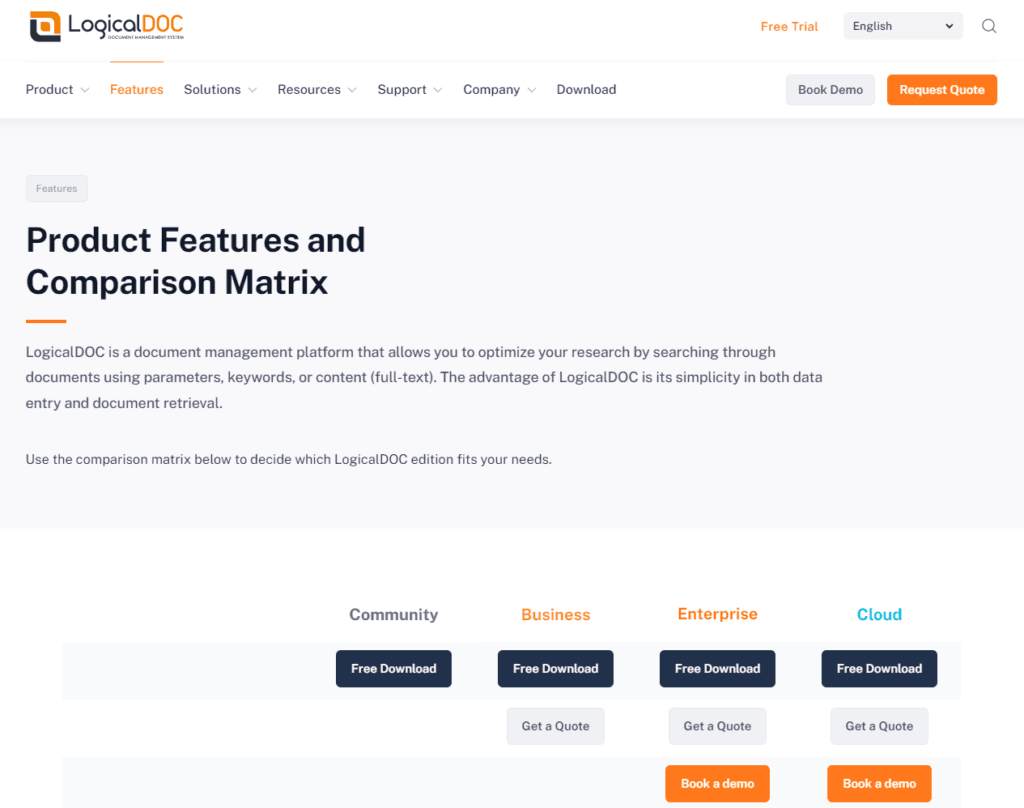Choosing the right document management tool is akin to finding the perfect assistant; it should make your work life smoother, not more complicated. In the vast sea of options, Revver and LogicalDOC float to the surface as two of the most promising contenders. But the question remains: which one will be the Robin to your Batman, the Watson to your Sherlock? If you’re drowning in a sea of features, pricing plans, and technical jargon, fear not. We’re about to embark on a no-nonsense journey to dissect these tools, laying out the facts in the simplest terms. Let’s dive into the nitty-gritty and figure out which document management tool is the best fit for you.
| Revver | LogicalDOC |
|---|---|
 |  |
| G2 Score -4.3 out of 5 | G2 Score -4.4 out of 5 |
| TrustRadius Score -8.6 out of 10 | TrustRadius Score -8.2 out of 10 |
Usability: Your Daily Driver
When it comes to tools we use every day, usability isn’t just a buzzword; it’s the bread and butter of productivity. A tool could have all the advanced features in the world, but if it’s as user-friendly as a hedge maze, it’s going to do more harm than good. So, how do Revver and LogicalDOC stack up in the ease-of-use department? Let’s find out.
Revver: Intuitive from the Get-Go
Revver prides itself on an interface that’s cleaner than your grandma’s kitchen. It’s designed with the user in mind, making document management feel like a walk in the park rather than a hike up Everest. Right from the start, Revver welcomes you with a straightforward dashboard that neatly categorizes your documents, tasks, and collaborations.
What sets Revver apart is its minimal learning curve. New users can jump right in and start managing their documents without a lengthy onboarding process. Uploading, sharing, and organizing documents is intuitive, with most functions being drag-and-drop. Revver also includes helpful tooltips and guides for its more advanced features, ensuring users can take full advantage of what it offers without getting lost in technical details.
LogicalDOC: Feature-Rich and Flexible
LogicalDOC takes a different approach. It’s like the Swiss Army knife of document management tools – packed with features and ready for just about anything. This platform caters to users who crave flexibility and customization in their document management system. From comprehensive indexing and search functionalities to extensive workflow automation capabilities, LogicalDOC doesn’t shy away from offering power tools.
However, with great power comes a steeper learning curve. New users might find the abundance of features daunting at first glance. But here’s the kicker: LogicalDOC offers detailed documentation and support to guide you through its labyrinth of features. Once you get the hang of it, you’ll find that its interface is more intuitive than it initially appears, offering customizable views and shortcuts for your most-used functions.
Pricing: The Investment in Efficiency
In the realm of document management tools, pricing is more than just a number—it’s a reflection of the value the tool brings to your workflow and the efficiency gains you can expect. With businesses always looking for ways to optimize their operations without breaking the bank, understanding how Revver and LogicalDOC structure their pricing models is key to making an informed decision. Let’s break down the pricing strategies of these two platforms and see which might offer the best return on investment for your needs.
Revver: Transparency and Flexibility

Revver adopts a clear and flexible approach to pricing, aiming to accommodate businesses of various sizes and needs. Typically, Revver’s pricing structure is tiered, offering several plans that escalate in features, storage capacity, and support levels. This allows you to start with a plan that fits your current requirements and scale up as your business grows.
At the entry-level, you might find a basic plan that’s either free or priced affordably, designed for small teams or startups just beginning to organize their document management processes. These plans usually include core document management functionalities like storage, sharing, and basic collaboration tools.
As you move up the tiers, the plans become more robust, adding advanced features such as enhanced security options, more sophisticated collaboration tools, and higher storage capacities. The higher-tier plans are also likely to offer more personalized support, including dedicated account management and priority customer service.
Revver’s pricing often reflects its commitment to scalability and support, making it a viable option for businesses looking to grow their operations without switching document management systems down the line.
LogicalDOC: Comprehensive Solutions with Clear Costs

LogicalDOC’s pricing strategy focuses on providing comprehensive solutions with a clear cost structure. Similar to Revver, LogicalDOC offers tiered pricing plans, but with a strong emphasis on delivering a complete set of features even at the lower tiers. This approach is particularly appealing to businesses that need a wide range of functionalities from the get-go.
The entry-level plans of LogicalDOC are designed to cater to small to medium-sized businesses, offering a solid foundation of document management capabilities, including advanced search, version control, and basic workflow automation. These plans are competitively priced, ensuring that even smaller teams can access powerful document management tools.
At the higher end, LogicalDOC’s plans expand to include full integration capabilities, custom workflow design, and extensive support and training services. These premium plans are tailored for larger organizations or those with specific, complex document management needs, providing a level of customization and support that justifies the higher investment.
LogicalDOC’s pricing model is transparent and geared towards delivering value, ensuring that businesses of all sizes can find a plan that meets their needs without paying for unnecessary extras.
Collaboration Capabilities: The Heart of Teamwork
In today’s work environment, where remote work and digital offices are becoming the norm, the ability to collaborate effectively is more important than ever. A document management tool should not only store your files but also enable you and your team to work together seamlessly, regardless of where you are in the world. Let’s see how Revver and LogicalDOC facilitate collaboration, and which one might be the better teammate for your projects.
Revver: Bringing Teams Together, Effortlessly
Revver shines when it comes to collaboration. It’s designed with teamwork at its core, making it easy for users to share documents, provide feedback, and track changes in real-time. The platform’s collaborative features are built into its DNA, allowing for a smooth workflow that feels natural and intuitive.
One of the standout features of Revver is its real-time editing and commenting capabilities. Multiple team members can work on the same document simultaneously, with changes visible as they happen. This eliminates the need for back-and-forth emails or separate chat apps to discuss edits. Revver also offers a version history feature, ensuring that no idea gets lost in the shuffle and you can always revert to a previous version if needed.
Furthermore, Revver integrates with popular communication tools, enhancing its collaborative prowess. These integrations allow teams to stay connected and informed, whether they’re working on detailed reports, planning documents, or creative content.
LogicalDOC: Customization Meets Collaboration
LogicalDOC approaches collaboration with a focus on flexibility and customization. It offers a comprehensive suite of collaboration tools, but what sets it apart is the ability to tailor these tools to fit the unique workflows of different teams. LogicalDOC’s collaboration features include document sharing, version control, and the ability to set up specific workflows for document review and approval.
A unique feature of LogicalDOC is its workflow engine, which can be customized to automate various collaboration processes. For example, you can create a workflow that automatically sends a document to specific team members for approval once it’s uploaded. This not only streamlines the collaboration process but also ensures that everyone knows their role and responsibilities, reducing the chance of tasks falling through the cracks.
LogicalDOC also supports integration with several external platforms, although its focus is more on enhancing the document management experience rather than integrating with communication tools. This means that while collaboration is robust within the platform, teams might still rely on external tools for day-to-day communication.

Related: Check out our free SEO suite

Integration Capabilities: Bridging the Digital Divide
In our modern work environment, the ability to seamlessly integrate with other tools and services is not just convenient; it’s crucial. The best document management tool is one that doesn’t force you to work in isolation but instead acts as a conduit, connecting various aspects of your digital workspace. Let’s see how Revver and LogicalDOC stand up to the challenge of integration, enhancing your workflow through connectivity.
Revver: The Centerpiece of Your Digital Workspace
Revver positions itself as more than just a document management system; it aims to be the centerpiece of your digital workspace. Its strength in integration lies in its ability to connect with a wide array of third-party apps and services, ensuring that your documents can flow freely between different platforms without friction.
From cloud storage services like Google Drive and Dropbox to productivity apps such as Slack and Trello, Revver ensures you’re never more than a few clicks away from the tools you use daily. This extensive network of integrations makes it easy to bring your documents into the flow of your work, whether that’s sharing a draft via Slack or attaching a document to a Trello card.
Moreover, Revver’s API opens the door for custom integrations, offering the flexibility to connect with proprietary systems or niche tools specific to your industry. This level of connectivity is a boon for businesses looking for a document management system that can adapt and grow with their evolving tech stack.
LogicalDOC: Focused Integration for Streamlined Workflows
LogicalDOC takes a slightly different approach to integration. While it may not boast the breadth of third-party connections that Revver does, it focuses on depth, ensuring that its integrations add significant value to its core functionality. LogicalDOC integrates with major enterprise resource planning (ERP) systems, customer relationship management (CRM) tools, and other business-critical applications, facilitating a seamless flow of information across departments.
A standout feature of LogicalDOC’s integration capabilities is its compatibility with office suites like Microsoft Office and Google Workspace. This allows users to edit documents directly within LogicalDOC using the office tools they are familiar with, bridging the gap between document management and content creation.
LogicalDOC also offers an API for businesses that need to develop custom integrations, ensuring that even the most specialized tools can be connected to your document management system. This approach to integration emphasizes efficiency and aims to enhance the core workflows of businesses, especially those in sectors with specific software requirements.
Conclusion
Choosing between Revver and LogicalDOC for your document management needs boils down to a series of considerations about what’s most important for your team or organization. Both platforms offer robust features designed to streamline the process of managing documents, enhancing collaboration, and integrating with other tools. However, their approaches and strengths cater to different preferences and needs.
READ NEXT:
- Revver vs Quip: The Best Document Management Tool for You
- 21+ Top Document Management Software for Businesses: A Deep Dive
- SharePoint vs Quip: The Best Document Management Tool for You
- Woopra vs Optimizely: The Best Analytics Tool for You
- Woopra vs Heap: The Best Analytics Tool for You
- Vtiger vs Agile CRM: The Best CRM Tool for You






















Comments are closed.